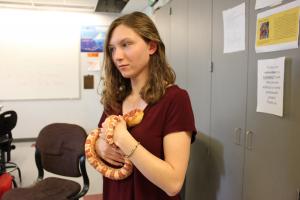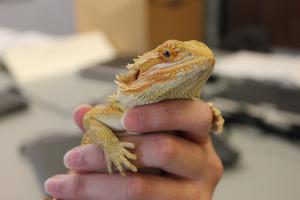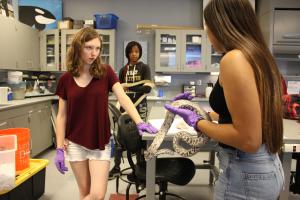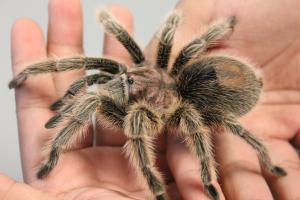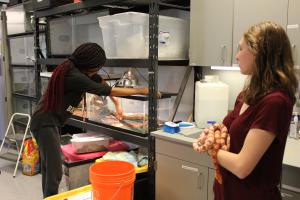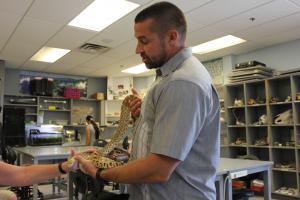Editor’s note: This is the fourth in a series of sustainability stories we’ll bring you over the summer. From our burrowing owl habitat and recycling efforts to our solar panels and garden, EMCC prides itself on its many sustainability practices. As Physics Professor Dr. Dwain Desbien said at the 23rd Annual Commencement Ceremony, “The best goal you can have in life is to leave the world a little better place for you having been in it.”
Some students call it “The Animal Room.” Others call it “Jarod’s Lab.” For Estrella Mountain Community College’s (EMCC) Animal Ambassadors, it’s Home Sweet Home.
Located in Room 125 on the south side of Montezuma Hall, this is where a handful of students spend countless hours caring for bearded dragons, ball pythons, Russian tortoises, and even a rose hair tarantula named Grape. They are part of a fairly new program at EMCC. Started in 2017 by Life Sciences Professor Jarod Raithel, and STEM Coordinator Liahla Roberts, the Animal Ambassadors program provides students with numerous hands-on opportunities.
The students, some of whom are unpaid volunteers while others receive stipends from WASEO (Western Alliance for the Expansion of Science Opportunity) grants and WIRCCS (Works Internships Ready Community College Students) Internship Scholarships, clean the animals’ cages, feed them, and regularly handle them. Handling, which for most is probably the best part of the job, is necessary as these students take the collection of critters to outreach events several times throughout the year. Whether teaching Luke Days attendees the differences between a gopher snake and a rattlesnake or assuaging Boys & Girls Club members’ fear of spiders with the ever docile Grape, this is where the Animal Ambassadors really get to shine.
The outreach events are a win-win. Pre- and post-presentation surveys regularly show that positive interactions with animals influence people’s perceptions. Many of those who report a fear of snakes before the presentation change their answers by the end, for example. The same holds true for those who initially think all snakes are venomous. But the biggest beneficiaries of the program just may be the students themselves.
“We’ve seen so many students come out of their shells,” Roberts said. “And it’s really helped develop their leadership skills. We really do try to give them that leadership role where we’re their supporters, their mentors, but they’re the ones running it.”
They also forge friendships and learn how to work in groups.
“When they move on, they’re able to coordinate within a group setting, take those leadership skills, but still take in the perspectives of other people and take in that feedback,” Roberts said.
The program is multifaceted, requiring students to journal and log their hours.
“That way, they can translate that back into their resume and articulate what they’re doing in words,” Roberts said. “It’s very important because that’s what makes them stand out. Those key phrases are going to put them above someone who did not mention that they had that experience.”
Animal Ambassadors on the WASEO grant are also required to complete a research project. David Rosalez, who has been an Animal Ambassador since the program began, has completed several projects, including creating a system for keeping track of tank cleanings, feedings, and sheddings; breeding mealworms to be fed to the program’s “beardies”; and launching campus compost projects.
“David has been an all-star in the program,” Raithel said.
David graduated from EMCC in the spring and is transferring to Arizona State University to obtain his bachelor’s. He plans on becoming a wildlife biologist.
“The Animal Ambassador program was definitely a big stepping stone for me because I had no idea what I was going to do when I was looking into the biology program,” David said. “I just happened to fall into this internship and it’s been really helpful for me in my future career.”
The lab is open to the public from 2 to 4 p.m. Monday through Thursday during the summer. An Animal Ambassador is always on hand to give tours and discuss the animals.
“The whole idea is we want the students to get used to teaching people about the animals and we want the animals habituated to being handled,” Raithel said.
David said teaching people about animals is one of the best parts about being an Animal Ambassador.
“Almost every shift I have, people walk in and I give them the tour,” he said. “It’s pretty fun, especially when you see their reactions holding the animals for the first time. You can see it in their eyes and their smiles, and you know it’ll last a lifetime.”
